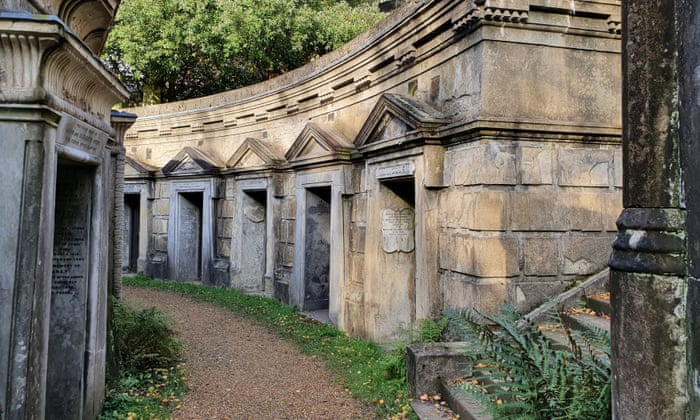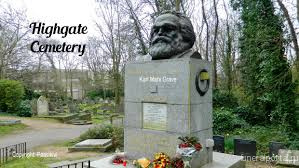What would Marx say? Visitor centre and cafe planned for historic London burial ground to capitalise on growing public appetite for genealogy while raising vital funds for upkeep

Highgate cemetery attracts thousands of visitors a year. Photograph: Friends of Highgate Cemetery Trust/PA
It’s a development that its most famous occupant might have predicted, even if it would have him spinning in his well-visited grave.
North London’s Highgate cemetery, final resting place of Karl Marx, is to undergo a makeover to enhance its visitor experience. In addition to a spot of landscaping, it will have an exhibition space, a separate gift shop and possibly a cafe.
Home to the remains of 170,000 people, Highgate, which opened in 1839, is the latest cemetery seeking to capitalise on the public’s growing interest in death. Brompton cemetery in south London has recently been given a makeover which saw buildings restored and a lodge turned into a visitor centre with the help of a £4.5m grant from the National Lottery Community Fund.
And Brookwood cemetery in Surrey, which has been operating since 1854 when London’s cemeteries became overcrowded following a cholera epidemic, is now opening a museum of death.
“People used to think that visiting cemeteries was a bit weird, a bit ghoulish, a bit morbid,” said Dr Ian Dungavell, head of the Friends of Highgate Cemetery Trust which maintains the cemetery with no public funding. “Now they are realising that cemeteries are part of our historic cultural environment.”
This would perhaps not be a surprise to Marx, who observed in the Communist Manifesto: “In bourgeois society... the past dominates the present.”
But Dungavell suggested it was actually a vogue for family history, popularised by online genealogy sites, and a more open attitude to discussing death, that had seen death tourism come back into fashion.
“There’s a sort of circularity about these discussions. When Highgate opened, cemetery tourism was a big thing, not just in London. If you went to Paris in the 1830s, one of the top places to go was Père Lachaise – it was a must-see.”
Highgate, which today draws 100,000 paying visitors a year, up from 63,000 seven years ago, opened before London had public parks, offering a day out for city dwellers. At the time, it took out advertisements boasting of its unrivalled views across the capital and the splendour of its Egyptian architecture.
But as cemeteries fell out of fashion with more people opting for cremation, Highgate, once used as a horror location by Hammer films, fell into benign neglect and nature attempted to take back the gravestones.
“There is an aesthetic attraction,” Dungavell acknowledged. “Monuments are tumbling down and ivy is growing over them. It can be quite moving. There is sense that nature has it in for all of us – it’s going to win. That’s quite poignant, and people really appreciate that. But romantic decay is still decay, and as the trees get bigger the potential for damage becomes much greater.”
The grave of Karl Marx in Highgate cemetery. Photograph: Richard Isaac/Rex
Aware of the sensitivities involved, the trust is to run one competition to challenge designers and architects to come up with a new landscape masterplan and another to improve facilities which will include new toilets, a separate shop and a cafe.
Of the latter competition, Dungavell said the winner would need to demonstrate “a very light touch”, one that respected the cemetery’s unique atmosphere. “You don’t want to feel that a visitor centre that could be found at any other visitor attraction has just been dropped in here.”
Jane Findlay, president of the Landscape Institute, which is working with Highgate on the competitions, acknowledged that there would be concerns.
“There has been a fear that any change could unintentionally destroy what people find special about the place, and so up until now a minimal intervention approach has been favoured,” Findlay said.
“But it has come to a tipping point where that is no longer sustainable. Some monuments are under threat from long-term decay and maturing self-seeded trees, and many trees are afflicted by pests and diseases brought about by climate change. More extreme weather is eroding gravel paths and overwhelming the historic drainage systems.”
In 2019, following a fungal attack, the cemetery lost a 250-year-old cedar tree which was at the heart of its Circle of Lebanon series of tombs.
Findlay said that many other cemeteries were also feeling the effects of the climate emergency. Last year the National Memorial Arboretum in south Staffordshire suffered some of the worst flooding in its history followed by one of the driest springs on record, an event that placed huge stresses on its plants and trees.
But, ultimately, Findlay suggested that cemeteries could play a part in countering global heating.
“The importance of cemeteries as urban green spaces is often overlooked. Relatively untouched by surrounding urban development, they often act as green oases. They offer special places for quiet, reflection and contemplation. And, like other green spaces, they have an important role in mitigating the effects of climate change, and provide a range of important natural habitats for many different – and often rare – plant life and animals.”

Exit through the gift shop as Highgate cemetery woos death tourists
https://www.youtube.com/embed/Ax9mBCbLsR4









